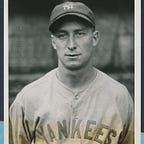Tuesday, May 31, 1927: Philadelphia
Sex in the City
 Schoolboy Hoyt is from Brooklyn. Gehrig’s from Manhattan. The Babe is from Baltimore. Urban Shocker’s from Cleveland. Lazzeri and Koenig are from San Francisco. But most of the players on the team, and most ballplayers in the majors and minors, are from small towns and farms. And, trust me, none of us are longing to leave New York City any time soon.
Schoolboy Hoyt is from Brooklyn. Gehrig’s from Manhattan. The Babe is from Baltimore. Urban Shocker’s from Cleveland. Lazzeri and Koenig are from San Francisco. But most of the players on the team, and most ballplayers in the majors and minors, are from small towns and farms. And, trust me, none of us are longing to leave New York City any time soon.
It’s like everyone was singing right after the Great War:
How Ya Gonna Keep ’em Down on the Farm, After They’ve Seen Paree?
Just about every guy who comes to New York is stunned by how forward the women and girls — and most of the women are still girls — are. Without feeling any shame, the broads are out to have as much fun as the guys. As Cy Moore said after finally having his first long night out on the town, “Sweet bullfrog, it sure seems like they got a lot more than just the right to vote in 1920.”
When I told that to Stanwyck, she just shook her head. “Sweet bullfrog? Someone should strap a plow on that hayseed and send him back to the fields.”
Stanwyck’s as independent as they come. Or go. And she does both. She shows up when and where she wants. And she leaves under the same conditions, often without a hello or a goodbye. It’s not rude. It’s just Stanwyck. Take it or leave it. And I’ve yet to meet anyone who has wanted to leave it.
During the day this town is all about money — and baseball. At night it’s all about booze, jazz and the possibility of sex. I’m sure there’s never been a time in recorded history when there’s been so much coupling and uncoupling, and coupling again.
It takes a while to get used to all the gals looking just to have fun, and not looking to find a husband. In fact, I think these new girls with their short skirts scare a lot of guys. As do some of the older broads.
 Mae West is an intimidating dame. She just got finished doing a short stint in prison because of a play she wrote and acted in.
Mae West is an intimidating dame. She just got finished doing a short stint in prison because of a play she wrote and acted in.
The play was called “Sex” — that’s the whole title, and most of the plot. It’s about a prostitute played by Mae (of course) who falls in love with a young well-to-do from Southampton. The details are hard to follow — since Mae’s not exactly George Bernard Shaw — but eventually it turns out that in Mae’s world being a whore, while nobody’s first choice, isn’t the worst thing a gal can do with her life.
When it opened last year, all the reviewers loudly panned it. Worse, none of the newspapers would even run advertisements for it, because they said they couldn’t print the word sex in their papers. But Mae soon had “Sex” all over town, literally, by putting advertisements on top of taxi cabs that said:
“HEATED. Mae West in SEX. Daly’s 63rd Street Theatre.”
The play sold out.
Every night for almost a year.
Until it was shut down under the new Padlock Law, designed to uphold the morals of New York City — and that’s some heavy lifting. Under the new law, the entire cast of “Sex,” the producers and Mae were all arrested and thrown in the Jefferson Market Jail on 10th Street and Sixth Avenue for the night, before being let out on bail to await trial.
Under the Padlock Law, the district attorney can shut down any play he deems immoral. That includes any plot about prostitution, homosexuality, or any play acted by real homos — and, as Schoolboy Hoyt pointed out to me, “Mae’s shows have as many whores and homos in them as Shakespeare’s have Englishmen.”
The “Sex” trial was front page news, and the courtroom was standing room only. After only two days a jury found the play (which they hadn’t read) and the performances (which they hadn’t seen) guilty, and the judge fined everybody $500 apiece. Then he told them he’d waive their fines if everybody promised in court that they would never perform the play again.
Everybody did.
Except Mae.
Mae refused to pay a cent.
She told the judge, in that strange voice of hers, “I think my play is … edju-cational.”
To teach her a lesson, the judge sentenced Mae to 10 days in the women’s prison on Welfare Island, just across the East River from Manhattan.
Stanwyck calls West “a talentless, cheap thrill who can’t act or write,” but she also told me, “I love the swell way she stood up to that prig of a judge, and so do a lot of the girls. After he told her that he was going to hold her in contempt of court, Mae told the papers, ‘I was trying my best not to show how much contempt I really had for his court.’”
After her sentencing, Mae thanked his honor for sending her to the hoosegow, and swore she’d find enough material in prison for a hundred new plays. Then she got in her limo, was chauffeured to the prison and, as Stanwyck proudly says, “She served her time like a man.”
Once Mae got to the big house, the papers say the warden was kind enough to let her wear her own silk underwear and give her a job in his private residence dusting his books. When her time was done, she handed the warden a check for a thousand dollars to start the Mae West Memorial Library for women. Honest.
Stanwyck says Texas Guinan and the gangster Owney Madden are planning to produce a Broadway revue based on Mae’s trial. They’re calling it, ‘Padlocks of 1927,’ and it’s opening in July. Billy Rose is writing the music, and George Raft is dancing in it.
If Stanwyck wasn’t already cast in another play in September, she’d be in it, too. She says that’s what Texas and Madden were talking about last month, when Benny and I were spying on them through Benny’s binoculars at the Stadium.
Stanwyck also says she’s heard a bunch of people are writing plays about Ruth Snyder’s trial.
 Ruth Snyder went on trial in the middle of April for killing her husband. Or more accurately, having her boyfriend kill her husband. Or more accurately than that, having her boyfriend kill her husband three different ways in one night.
Ruth Snyder went on trial in the middle of April for killing her husband. Or more accurately, having her boyfriend kill her husband. Or more accurately than that, having her boyfriend kill her husband three different ways in one night.
First her boyfriend, a corset salesman, named Judd Gray, bashed Mr. Snyder’s head in with a sash weight. Then he chloroformed him. Then he strangled him. The coroner’s report said the police were free to choose from any of the three as the cause of his death.
A few weeks before the trial started, Schoolboy told me that he had a boyhood pal, Ike Stier, who was the first Jew detective in New York, and that Ike had worked on the Snyder case. When I told this to Stanwyck, she grabbed me by the collar and said, “Tommy, we’ve got to get into that courtroom!”
Since court is in session during our games that wasn’t possible — until the weather turned bad and we got a couple of rainouts in a row. After the first rain day, when it didn’t let up and we knew the next day would either be rained out or called on account of wet grounds, Schoolboy phoned his pal, Detective Ike, and the next morning Stanwyck, Schoolboy and I drove out to the Queens County Courthouse.
 The front of the courthouse is a mob scene, with over a thousand people lined up to try and get into a courtroom that seats maybe two hundred. Everyone is desperate to catch a glimpse of Ruth Snyder and her lover and co-defendant, Judd Gray. Souvenir vendors are hawking Ruth Snyder postcards, buttons and pins.
The front of the courthouse is a mob scene, with over a thousand people lined up to try and get into a courtroom that seats maybe two hundred. Everyone is desperate to catch a glimpse of Ruth Snyder and her lover and co-defendant, Judd Gray. Souvenir vendors are hawking Ruth Snyder postcards, buttons and pins.
“It’s like a medieval hanging,” observes Hoyt.
“No,” says Stanwyck. “It’s like an opening night.”
Ike laughs. “Schoolboy, I’m thinking three seats to this trial are worth a season pass, at least.”
“Your badge is your season pass, Jewboy,” Schoolboy replies. “But Myles and I promise you two tickets to the World Series in return for this little adventure.”
“Be sure to smile for the cameras, boys” instructs Stanwyck, as we walk past a line of newspaper photographers.
Ike takes us around to the back of the courthouse and points out two paddy wagons sitting side by side. “Separate rides for the unhappy couple, now that they’re busily ratting each other out.”
He brings us into the building through the back entrance and introduces us to some of his detective pals before walking us into the packed courtroom.
Schoolboy works his way around the courtroom as if he’s at a Fifth Avenue cocktail party, first getting the lowdown on the trial from Damon Runyon, in from Chicago, and then chatting with the film director, D. W. Griffith, who excitedly tells Hoyt, “This is real drama!”
Stanwyck walks up to a priest and gives him a big hug. At least he looks like a priest. It turns out he’s a broadway director named Belasco whose affectation is to dress like a priest. (“Why the priest collar?” I later ask Stanwyck. “Why not?” she replies.)
I’m excited to meet Belasco because he’s the man who last year gave Ruby Stevens the name Barbara Stanwyck. It happened right before she got her breakout role in “The Noose.”
Stanwyck was just a dancer — a good not great one, but okay — when she got this small part playing a cabaret girl with only a couple of lines in a melodrama bound for Broadway. “The Noose” was about a young man who gets involved with mobsters and lands on death row. In the last act his society girlfriend goes to the Governor to plead for the young man’s life. But audiences during the out-of-town previews weren’t moved at all by the society dame, and the ending fell flat.
The woman producing the play decided to change the last act. It was rewritten so that the cabaret girl instead of the society dame goes to plead with the Governor — and, thinking the young man’s already dead, she pitiably begs the Governor to be allowed to bring his body back home, so she can give him a proper burial.
Stanwyck, still a Broadway nobody who had never really thought about being a serious actress, suddenly had a chance at her first real acting part. But she only had a few days to learn it. There was even more pressure on her because the producers started auditioning other girls for the role. She rehearsed for three days straight, spending nights at the theater. Maybe it was her exhaustion, but the third day something clicked. As tired as she was, she was as powerful as Gehrig at the plate. The part was hers.
From opening night through the run of the play, audiences had tears in their eyes during her speech, and gave her standing ovations. All the reviewers singled her out. And just like that, Ruby Stevens, a 19-year-old chorus girl, became Barbara Stanwyck the actress.
Belasco shakes Stanwyck. “Today we’ll see some real acting! This is a great dramatic struggle between two human beings, who once were lovers but now are fighting a battle to the death, not only against the state but with each other. My lovely panther, this is great drama!”
“That’s why I’m here!” Stanwyck excitedly tells him. “I can’t wait to see her.”
Stanwyck and Belasco are interrupted by the bailiff telling us that court is about to be called into session. We go to sit down — Ike Stier has reserved us house seats: eighth row, on the aisle.
Ruth Snyder and her former boyfriend, the corset salesman, Judd Gray, are brought in and seated at separate tables. They’re charged with the same crime but are testifying against one another.
The tabloids have made such a big deal about what a vixen Ruth is — endlessly mentioning her piercing eyes and shiny hair — but as she walks towards us, Hoyt leans across Stanwyck to quietly render his judgement. “Not exactly killer looks.”
“What?” whispers Stanwyck, annoyed. “This woman’s been in jail for weeks. She’s on trial for her life. And the first thing out of your mouth is that she’s not good looking?”
Stanwyck turns to me. I shrug my shoulders and say, “He’s right.”
“I know,” she says under her breath, so only I can hear.
“All rise!” shouts the bailiff.
Court is called to order. And we’ve hit the jackpot. Today Judd Gray’s confession is being read into the record by the District Attorney, who will then cross examine him.
The juiciest part of Gray’s confession is when he admits that he murdered Snyder, but swears it was only because Ruth bewitched him, using her amazing sexual prowess, which rendered him not only powerless against her carnal and venal desires but also temporarily insane.
Ruth’s sexual abilities were so great, Judd claims, that he didn’t know where he was, or what he was doing to Mr. Snyder. From other parts of his confession, though, it’s pretty obvious that he knew what he was doing to Mrs. Snyder. Repeatedly, and frequently, in a room at the Waldorf Hotel.
The D.A. reads aloud to the court:
“With veiled threats and lovemaking she reached the point where she got me in such a while that I didn’t know where I was at.”
I lean across Stanwyck and whisper to Hoyt, “I was temporarily insane last night. But only for about seven minutes.”
“If that,” snorts Stanwyck.
Schoolboy whispers back, “I’ve never felt that way long enough to commit a murder.”
Stanwyck chirps at him, “You’ve never felt that way for more than 90-seconds.”
“Think anyone will ever kill for you?” I whisper to Stanwyck.
“How do you know they haven’t already?” she softly replies. “There are a lot of unsolved murders in this town, you know.”
I look around the courtroom, which is packed, perhaps five hundred people in a space built for half as many, a barely ruly mob of curiosity seekers with nothing better to do with their lives, newspapermen looking to capitalize on the salaciousness of this story, photographers waiting to pounce with their flashes, tough looking cops, a hanging judge, and a prosecutor who looks like he would personally like to pull the switch on both Snyder and Gray. And I think to myself, “I’d kill for Stanwyck.”
Listening to his confession, it’s clear that Judd Gray is, in the words of Detective Ike Stier, “an amateur putz.”
After killing the same man three times, he wanted to make it look like a burglary. He scattered an Italian newspaper around the Snyders’ living room, to make it look like a band of Italian criminals had done the job. Then he tied up Ruth — apparently after another no-pants quickie — but he didn’t tie her rope tight enough to convince the detectives that it was something an actual robber had done.
Then, for his getaway car he chose … a city bus.
That last bit of brilliance got him identified as being near the scene of the crime at 6:00 a.m. by both a bus passenger and local cop.
 Ruth Snyder is a far shrewder animal than the dullard Judd. She was smart enough to trick her husband into signing a $50,000 life insurance policy, when he thought he was just signing up for $1,000. And then she added a “double indemnity” clause that would pay out $100,000 if he died a violent death. Given all the evidence that came out earlier in the trial, even if she’s not fried she won’t get to cash the check.
Ruth Snyder is a far shrewder animal than the dullard Judd. She was smart enough to trick her husband into signing a $50,000 life insurance policy, when he thought he was just signing up for $1,000. And then she added a “double indemnity” clause that would pay out $100,000 if he died a violent death. Given all the evidence that came out earlier in the trial, even if she’s not fried she won’t get to cash the check.
Stanwyck intently watches Snyder throughout the reading of Judd’s confession, and during the D.A.’s cross examination. Most of the time Snyder sits still, unshaken by the the testimony and the cross, almost all of which is a lurid tale about her. But other times she shakes her head “No,” or slumps back in her chair. Occasionally she even stares across the room at her former lover with, as the saying goes, a look that could kill.
Then I notice it.
When Ruth Snyder shakes her head, Stanwyck shakes hers. When Snyder’s body tightens up, or relaxes, Stanwyck’s does the same. And when Snyder looks across the room, Stanwyck’s face remarkably wears the same expression.
She catches me watching her.
“You should be playing that part,” I say to her.
She whispers to me, “One day, I will.”
- 1927 Yankees
- David Belasco
- Judd Gray
- D.W. Griffith
- TEXAS Guinan
- WAITE Hoyt
- Owney Madden
- George Raft
- Billy Rose
- Damon Runyon
- Ruth Snyder
- Barbara STANWYCK
- MAE West
- How Ya Gonna Keep ’em Down on the Farm (After They’ve Seen Paree)?
- NEW YORK TIMES, April 28, 1927: Coverage of the Snyder-Gray Trial
- NEW YORK TIMES, April 20, 1927: “Mae West Jailed With 2 Producers”
- The Noose
- Original New Orleans Jazz Band
- Padlocks of 1927
- Ruth Snyder-Judd Gray Murder Trial
- Sex
“Hooded Baseball.”
While many members of the ’27 Yankees came from humble beginnings, the blue-blooded Herb Pennock was not one of them. Myles learns about Pennock’s aristocratic past, and how he uses his family’s wealth to support a baseball team fielded from the unlikeliest of sources: the Ku Klux Klan.
Pennock tells me, “The Klan has baseball teams all around the country, and I give money to outfit them.”
“Shit, Herb. It must be terribly difficult to run the bases in those robes.”
